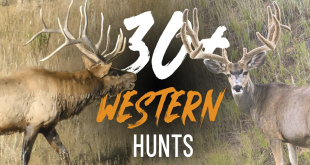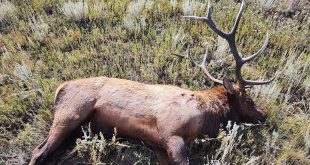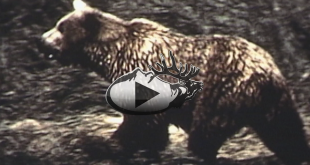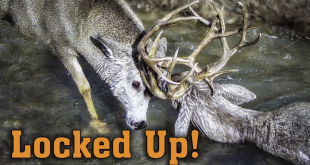
“Talk of your cold! through the parka’s fold it stabbed like a driven nail.
If our eyes we’d close, then the lashes froze till sometimes we couldn’t see;
It wasn’t much fun…” The Cremation of Sam McGee – Robert W. Service
Snow, ice, sub-freezing temperatures, bleak landscapes seemingly void of life… what’s not to love about late-season big game hunts. Now before all you snowbirds who fly South to chase Coues’ deer or rutting mulies in the deserts of the southwest begin to gloat please understand what I’m talking about here are the November, December and even January hunts for deer, elk, goats and sheep in the northern reaches of the West where venturing out to pursue big game this time of year demands a stoic determination bonded with an iron will because there are no other hunts that will test a big game hunter’s mettle more than these, where conditions can be downright life threatening.

Late-season big game hunts are risky propositions. There are a wagon-load of variables stacked against the hunter; extreme cold, deep snow, migrating animals and limited tags all stack up a wall of difficulty for hunters to overcome. Some of these hunts are very limited, there just aren’t an awful lot of tags given out for them. As an example, in our neck of the mountains there are several late bull elk hunts that are meant to capitalize on the late migrating giant bulls of the Greater Yellowstone Ecosystem. These hunts are no secret but drawing one of the highly coveted and very elusive tags is difficult at best. However, drawing the tag is only the first step down the difficult path of tagging one of these late-season bulls.
The dates of these particular hunts fall during the time of year when Wyoming’s mountains experience their most hostile and unpredictable weather. Add to that the terrain of the units and you’ve got a recipe for one of the wildest and most demanding adventures of a lifetime. But with great risk can come great reward. Successful hunters with these tags routinely take some of the Cowboy State’s largest bulls each year but they earn them. Back to that wagon brimming with variables and even dangers.
- Extreme Temperatures – Late November, December and January in the Rocky Mountain West can be the most brutal months of the year. The region normally endures an extreme cold snap at this time and daily high temperatures can hover in the single digits for weeks on end. If there is any wind at all the wind chill factors plummet into the dangerous zone where exposed flesh freezes in minutes. It takes the right gear and the skills to use it to be able to hunt big game in these temperatures. I’ve personally suffered temps that bottomed out a little zipper pull thermometer whose coldest reading was -20 degrees Fahrenheit. Those temperatures made glassing very hard and sitting still for any extended periods nigh on impossible. However, the elk appeared to be unaffected, even hunkering down on exposed ridgelines in the howling wind so they could have an unfettered view of any predators coming for them.
- Snow – Most folks out West rely heavily on their optics and being able to put them to use to find success on a hunt. Snow can severely hamper a hunter’s ability to use their glass. In case you’ve never tried it glassing in a blizzard is virtually impossible and late-season hunts can be plagued by blizzards that last for days, eating up valuable time on what are normally quite short seasons. If you’re visibility is limited for five days out of a 10 day hunt you’ve lost 50% of your already limited opportunity for punching your tag. Most windows of success on these late hunts can be measured in hours and losing any of them can be frustrating at best and hunt ending at worst.
- Access – I’m not talking public access here what I’m referring to is the ability to actually reach the animals you spot. In the case of late-season bull elk, bighorn rams and mountain goats the windblown ridges they prefer during these months can be all but unreachable. Deep snow below these ridges coupled with heavy and downed timber can serve as an almost impenetrable barrier. Having hardy stock such as seasoned mountain horses can make access possible if the terrain isn’t too rugged, which in the case of mountain goats especially, can be the norm. However, using horses in extreme conditions opens an entirely new can of worms; caring for the animals will add hours to your already short days and getting feed for them on extended hunts in the backcountry will require you to most likely pack it in, demanding more animals than needed on early season hunts. The logistics of accessing a big bull, buck or ram are not to be taken lightly. Last season I had the chance to visit with a lucky hunter who had earned a giant bull during one of these late-season hunts. The gentleman had found the bull fairly early on after sorting through several top tier animals but then the weather settled in and he couldn’t even glass the elk for over a week. He went home and waited for better weather, home was over a thousand miles away. When the weather broke he returned, found the bull again and then spent three more days figuring out how to access the animal. The bull had sequestered himself atop a 9500’ windswept ridge with dark timber and waist deep snow on all sides. Needless to say getting to him was yet another massive undertaking. Horses were used and the man got his elk, a true late-season monarch but success was much harder to attain than it would have been earlier in the year.
- Or Not! – Even though most years the temperatures and weather during these hunts can be brutal that’s not always the case and when the temps don’t bottom out and the snow doesn’t pile up the animals don’t follow the late-season script. Without deep snow and extreme temps migratory animals will often only move as far as needs be to keep them alive. There’s no sense in a bull elk migrating a couple hundred miles if he doesn’t have to. In fact, his survival demands that he expend as little energy as possible this time of year. If the nasty weather of winter does not come then the unit you’ve drawn or tag you’ve bought may not even have animals in it. For example, there’s a late ek hunt I’ve applied for here in Wyoming that can be spectacular given the right nasty weather rolls in and pushes the elk down low. I’ve never been fortunate enough to draw this tag but have several buddies who have and when the weather has cooperated they’ve taken home big bulls. When it hasn’t they’ve struggled to find a single bull let alone a big boy.

As you can see, late-season big game hunts can be and often are butal endeavors, demanding a hunter’s best skills and unwavering commitment. This begs the question… why endure all this for a buck, bull, ram or billy? There may be no better time of the year than the bitter months of winter to take your biggest animal ever.
- The animals are normally quite visible this time of year and easy to locate. The elements demand that they spend quite a bit of time feeding and this makes them much more simple to find than they are earlier in the season when they spend an awful lot of their time feeding under the cover of darkness.
- There is limited competition for the animals you find. These late-season hunts are often quite limited in nature think fewer than 25 tags in many cases. This means that when you do find that giant buck, bull, ram or billy you may be the only one hunting him and that’s an enormous advantage.
- Trophy quality! In the case of bull elk and mountain goats the quality of the hair during the late season is unsurpassed. Billys have that long flowing hair they are prized for during the winter months and many hunters simply won’t pursue them unless their hair is long. As for bull elk, there’s something incredibly impressive about that long mane they grown during the winter months. It makes a mounted bull all the more impressive when he’s sporting a full winter cape.
So now that I’ve gotten your attention with the warning about how hard late-season hunts can be and I’ve shown you why they are worth the demands placed on the hunter we need to take a look at where these hunts exist. Wyoming isn’t the only place where late-season hunts for antlered and horned animals take place and while the current trend by game agencies is to phase out late hunts there are still places where those possessed of adventurous spirit, grit and determination can chase mature bucks, bulls, billies and rams late into the year and even into the new year as well. Look to Wyoming, Idaho, Montana, Colorado, Nevada and even the Dakotas if you’re in search of a frost-bitten late-season quest. Notice I don’t mention Arizona as we are talking about weather dependent hunts and frankly, Arizona doesn’t hold a candle to Montana or Wyoming for the brutality of the weather.
There are other late hunts in other states but the six or seven I’ve listed offer the best options for deer, elk, sheep and mountain goats. Look to the Eastmans’ MRS for full details on tag numbers, dates, draw odds and success rates in the coming months to make your application decision if a challenging late-season hunt is what you’re after. Remember, the best stories often come from the most challenging circumstances.
Sidebar – Late Season Gear – A Literal Lifesaver!
Times have changed and thank goodness so has the late-season gear I now use. The demands of late-season western hunting place a premium on durability, warmth and light weight. Your gear needs to be able to keep you alive at worst and comfortable at best and today’s hunting gear companies have those requirements dialed. Here’s a breakdown of my late season essentials sprinkled with a few favorites.
- Shells/Outerlayers – While your standard rain gear will work to keep you dry and protected from the wind there are late-season specific options such as the Sitka Blizzard system and Kryptek Vellus Series that are purpose built for extreme protection from extreme elements.
- Insulation/Puffy layers – This is an area where technology has made leaps and bounds in not only keeping hunters comfortable but helping them pack that comfort everywhere they go. Both jacket or a vest and pants should be in your arsenal and every hunting clothing company offers several options.
- Pants/Bibs – Pants and bibs have also gotten easier to wear and move about in while keeping hunters warm and dry. I really like the Blizzard Bib Pant or Coldfront Pant from Sitka for ultimate warmth and bomber construction.
- Baselayers – The debate over synthetic vs. Merino wool continues to rage but for late-season conditions Merino wool gets the nod. It’s warm, dries fast and feels good against your skin. I like a heavyweight option for the late season as that weight provides the greatest warmth and I can strip down to just that baselayer for high exertion intervals. First Lite’s Kiln Hoody and Furnace Long John are great options.
- Socks, Hats, Gloves – This category often gets overlooked but it shouldn’t. There are a ton of options here that will all work well and personal preference plays a large role in selection. However, I’ve gravitated to the simple wool or fleece beanie, liner gloves and a large insulated over mitten such as Sitka’s Blizzard GTX mitten or Kryptek’s Briareos Glove. For socks I choose a lightweight synthetic liner against my skin and the heaviest wool boot sock I can find. The First Lite Zero Cold Weather OTC is a solid performer. May want to add in Kenetrek socks…they are KILLER!
- Boots – Pack boots get the green light for me during the late season. I love their warmth and flexibility in extreme cold temps. Schnee’s and Kennetrek are the best I’ve found. If you need a more supportive boot that is still warm, look for something boasting 1000 grams of insulation.
- In the Pack – In my backpack during a late season hunt there are some items that can not only make life better but could also save it in a pinch.
- Firestarter – two methods for starting a fire.
- Portable stove – Jetboil or MSR type
- Water – Pack more than you think you’ll need, trust me!
- Food – High calorie, high fat snacks… the Inuit diet consists mainly of fat, think about it.
- Tea or Coffee – A hot drink is awfully nice.
- Foam pad – Sitting in the snow sucks, no matter how good your clothing is.
- Sunglasses – Bright sun and snow are a nasty combination.
- Lip balm – Dry cold and wind destroy your lips, can be used on hands too.
This is a glimpse into my late-season essentials, yours can and should vary depending on personal preference. However, the late-season is not a time to try and save weight or go cheap. Brutal weather and conditions will test both you and your gear to the utmost limits.
 Eastmans' Official Blog | Mule Deer, Antelope, Elk Hunting and Bowhunting Magazine | Eastmans' Hunting Journals
Eastmans' Official Blog | Mule Deer, Antelope, Elk Hunting and Bowhunting Magazine | Eastmans' Hunting Journals




